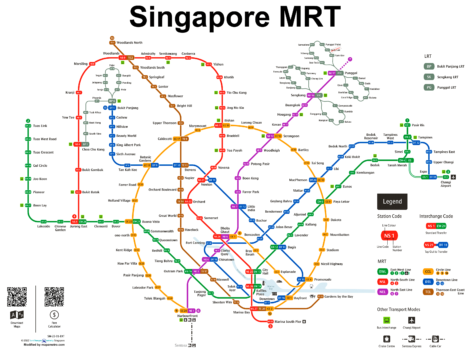Singapore Mass Rapid Transit, locally known as Mass Rapid Transit (MRT), It is the most important public transport system in the city-state of Singapore.
Inaugurated on 7 November 1987, This system has grown to include 203 kilometres (126 miles) of roads that serve 122 stations on six lines. The MRT is vital for population mobility, with millions of passengers using it daily.
subway map
Below we show you the Singapore metro map. Click on the image to see it larger:

we have the same Singapore metro map in PDF format.
Official Web site
- Singapore Metro Official Website: Land Transport Authority (LTA).
- Website with all attractions and shows in singapore.
Schedules
- Monday to Sunday: 5:30am a 12:30am.
- Festive: 6:00am a 1:00am.
Singapore Metro Fares
Singapore's MRT fare system is based on distance traveled. Below is a table with the main prices in Singapore dollars (SGD) and its equivalent in US dollars (USD) so that tourists get an idea of the price:
| Distance traveled | Card rate (SGD) | Card rate (USD) |
|---|---|---|
| Until 3.2 km | 1.09 | 0.81 |
| 3.3 km – 4.2 km | 1.19 | 0.88 |
| 4.3 km – 5.2 km | 1.30 | 0.96 |
| 5.3 km – 6.2 km | 1.40 | 1.03 |
| 6.3 km – 7.2 km | 1.49 | 1.10 |
| 7.3 km – 8.2 km | 1.56 | 1.16 |
| 8.3 km – 9.2 km | 1.63 | 1.22 |
| 9.3 km – 10.2 km | 1.67 | 1.25 |
| 10.3 km – 11.2 km | 1.71 | 1.28 |
| 11.3 km – 12.2 km | 1.75 | 1.31 |
| More of 12.2 km | 1.79 | 1.34 |
In addition to regular rates, There are various cards and passes that offer discounts and special benefits:
- EZ-Link Card: A rechargeable card that makes payment on public transport easier. Can be used on buses and trains.
- Singapore Tourist Pass: Offers unlimited rides on the MRT, LRT and buses during 1, 2 o 3 days at a fixed price.
- Monthly Travel Pass: Available for adults at a price of 128 SGD (96 USD) a month, allows unlimited travel on buses and trains.
- Concession Cards: Student discount cards, older people and people with disabilities, who can enjoy reduced rates and monthly passes with special rates.
For more information and up-to-date details on rates and card types available, you can visit the sitio web del Public Transport Council and the Land Transport Authority.
History of the Singapore Metro
Planning for the Singapore Metro began in 1967, when city planners recommended a mass transit system to relieve traffic congestion.
In 1982, after extensive studies and debates, the government decided to invest 5 1 billion Singapore dollars to build the MRT, which would be the country's largest infrastructure project to date.
Construction began in 1983, directed by the Provisional Mass Rapid Transit Authority, which later became the MRT Corporation.
The 7 November 1987, The first section of the North-South Line was inaugurated, connecting five stations from Yio Chu Kang to Toa Payoh. In December 1987, nine more stations were added, extending Novena service to Outram Park.
The 12 March 1988, Prime Minister Lee Kuan Yew officially inaugurated the MRT system, which by then included additional stations on the East-West Line.
This expansion continued with the opening of the Northeast Line in 2003, the Circle Line in 2011, and the line Downtown in 2017. It is expected that the Line Thomson-East Coast is fully operational for 2023.
Singapore Subway Map History
The MRT map design has evolved significantly since its inception. In the decade of 1980, The first maps were designed by local engineers and foreign consultants who worked on planning the system. These maps focused on clarity and ease of use for new subway users..
As the system expanded, Several design and consulting companies were hired to update and improve the maps. Among them is the German company Vossloh Kiepe and the Japanese Kawasaki Heavy Industries, who participated in the modernization and expansion of MRT lines and stations.
In recent years, the Land Transport Authority (LTA) Singapore has implemented a more integrated and technological approach to the design of metro maps. This includes the creation of interactive maps available online and in mobile applications, providing real-time information on routes and service status.
For more information on the history and development of Singapore's MRT, you can visit the LTA website and the singapore roots portal.
Additional data
The MRT not only improves connectivity, but also boosts nearby property values and attracts investment. some stations, like Tiong Bahru, They are architectural icons and popular public spaces. The integration of the MRT with the bus system and integrated transport hubs has facilitated smooth and efficient transit throughout the city.
The most visited tourist places in Singapore are the following:
- Gardens by the Bay (Bayfront, Downtown Line): A futuristic park with vertical gardens and heated domes.
- Marina Bay Sands (Bayfront, Downtown Line): Casino complex, hotel and the highest infinity pool in the world.
- Sentosa Island (HarbourFront, North-East Line): Leisure island with beaches, theme parks and aquariums.
- Singapore Flyer (Promenade, Circle Line): Observation wheel offering panoramic views of Singapore.
- Chinatown (Chinatown, Downtown Line): Historic neighborhood with temples, Chinese markets and restaurants.
- Orchard Road (Orchard, North-South Line): Singapore main shopping street, full of shops and shopping centers.
- Singapore Botanic Gardens (Botanic Gardens, Circle Line): Botanical garden with an extensive collection of tropical plants and orchids.
